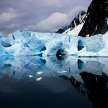
The Enigmatic Beauty of Antarctica: A Pristine Wilderness Unveiled
Have you ever dreamt of venturing to the Arctic, captivated by the allure of polar bears frolicking on ice floes or the mesmerizing dance of the Aurora Borealis across the sky? While these images might indeed be enchanting, allow me to reveal an equally captivating but less traveled destination - Antarctica.
Nestled in the southern hemisphere, at the South Pole, Antarctica is encompassed by the Southern Ocean and shrouded in ice, making it one of the most remote and extreme places on Earth. Yet, despite our dreams, very few have set foot on this pristine continent, primarily composed of glaciers and ice fields. The scenery and wildlife here, however, are unparalleled.
So, why is Antarctica so elusive for visitors? For starters, the environment is incredibly delicate, susceptible to damage from human intervention. Moreover, there are no indigenous human populations on the continent, rendering it an uninhabited, untouched oasis. And let's not forget the considerable expense involved in traveling to this extraordinary destination.
As a testament to its significance, Antarctica is not an unguarded frontier; rather, it falls under the jurisdiction of the Antarctic Treaty. The treaty ensures that unwanted activities and tests by member states are strictly prohibited, safeguarding the fragile ecosystem. As scientists continue to unravel the mysteries of Antarctica's unique ecosystem, human activity and machines must be restrained to preserve the delicate balance that exists there.
For those still yearning to explore Antarctica, obtaining permission is no easy feat. U.S. citizens, for instance, must complete a specialized form and submit it to the Office of Ocean and Polar Affairs. Once there, strict guidelines must be followed to protect the environment, including refraining from disturbing wildlife or taking souvenirs.
Technically, living in Antarctica is not prohibited by law, but it is a hostile environment, making it unsuitable for human habitation. With temperatures plummeting to negative 76 degrees Fahrenheit and beyond, survival without proper equipment and experience is nearly impossible. Moreover, the closest landmass lies over one thousand miles away, completely isolating any potential inhabitants from the rest of the world.
Antarctica's discovery is an intriguing tale, as it had no native human population. Ancient Greek philosophers called it "antarctos," signifying "opposite the bear" - not the polar bear, but the Great and Little Bear constellations, visible only in the northern hemisphere. This unique nomenclature denotes the opposite of the "land of the bear."
Exploratory voyages in the late 18th and early 19th centuries sailed further south when rounding Cape Horn, with Captain James Cook crossing the Antarctic Circle in 1773. Though he didn't sight land, he observed deposits of rock held in icebergs, hinting at a more southerly landmass.
The first confirmed landing on Antarctica occurred much later in January 1895 at Cape Adare during the whaling voyage of the ship Antarctic, captained by Henrik Bull.
Contrary to popular perception, Antarctica is a desert - a frozen desert. The minimal precipitation and vast ice sheets earn it this classification. The average rainfall over the past 30 years has been just over 0.4 inches, vastly different from the typical desert scenery we envision.
While Antarctica lacks camels and cacti, it teems with life. The frozen continent is home to billions of krill, attracting numerous seals and penguins. Penguins, with their streamlined bodies, are superb swimmers, adept at stealing pebbles from each other and forming precise huddles to stay warm. The emperor penguin, the largest species on Earth, resides here, capable of leaping up to 120 inches. Seals and whales also thrive in the frigid waters of the Southern Ocean.
As if being the driest, coldest, and windiest place on Earth were not enough, Antarctica poses a timekeeping challenge. All lines of longitude converge at the South Pole, leaving scientists and researchers to adapt their time zones to their countries of origin.
In conclusion, Antarctica remains a pristine wilderness, largely untouched by human activity. Its delicate environment demands respect and protection, as we continue to marvel at its unique wildlife and awe-inspiring landscapes from a distance. This frozen continent, with its enigmatic beauty, stands as a testament to the wonder and fragility of our natural world.






Comments
There are no comments for this story
Be the first to respond and start the conversation.